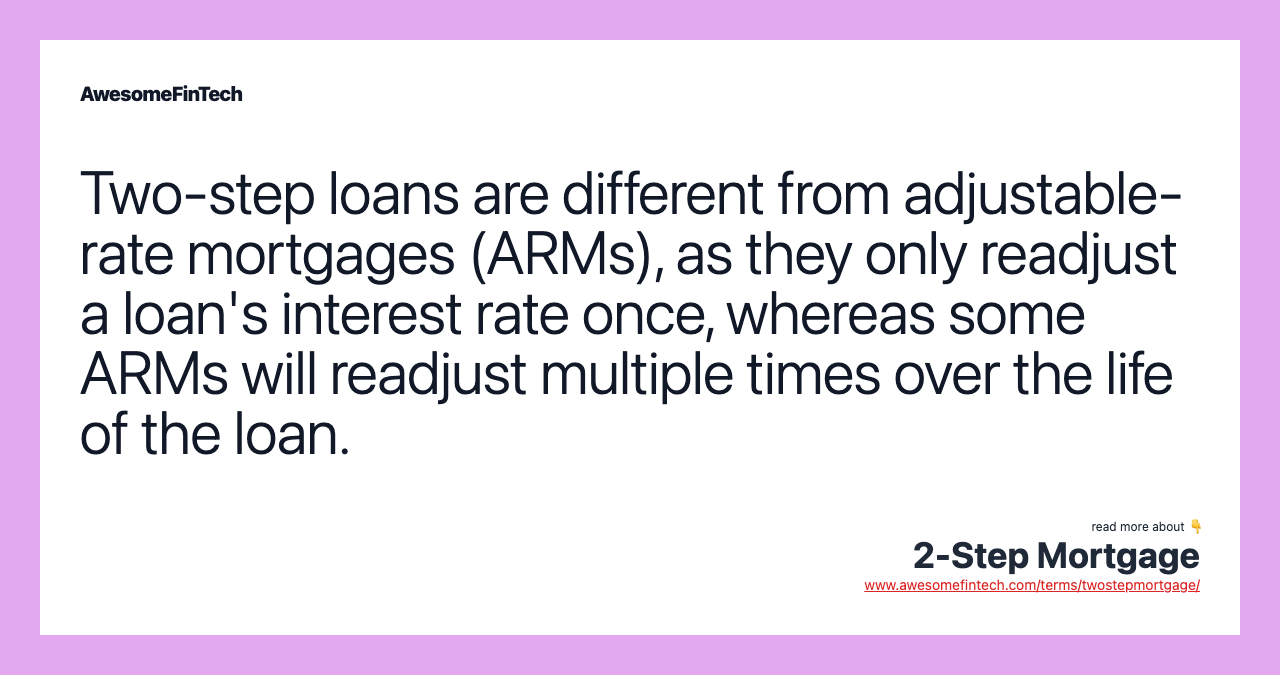2-Step Mortgage
A two-step mortgage offers a beginning interest rate for an agreed-upon introductory period. Two-step loans are different from adjustable-rate mortgages (ARMs), as they only readjust a loan's interest rate once, whereas some ARMs will readjust multiple times over the life of the loan. A two-step mortgage might also be undertaken by a buyer who expects that interest rates will probably drop during the initial rate period and therefore doesn't want to be locked into one rate for the duration of the loan. Also, buyers who believe that interest rates will fall during the loan's initial rate period are likely candidates for a two-step loan. This loan is generally interest-only for the initial period, with a higher interest rate but a much shorter life than a standard loan.

What Is a Two-Step Mortgage?
A two-step mortgage offers a beginning interest rate for an agreed-upon introductory period. This period usually lasts for five to seven years. A two-step loan often helps a borrower during the construction of a property. After completion of the structure and when the initial period ends, the interest rate adjusts to reflect prevailing interest rates.





Understanding a Two-Step Mortgage
A two-step mortgage is an attractive option for borrowers in certain situations. The classic consumers for a two-step loan are borrowers who want to enjoy a lower-than-market interest rate and lower monthly payment over the first several years of the loan. Other familiar two-step borrowers are homeowners who expect to sell the home before the initial period expires. Also, buyers who believe that interest rates will fall during the loan's initial rate period are likely candidates for a two-step loan.
Lenders are attracted to two-step mortgages because they bring in borrowers who might not otherwise qualify for a traditional loan. These borrowers absorb the market risk represented by rising interest rates.
Typically, the interest rate at the end of the initial period will be higher than the initial rate. When interest rates are higher at the end of the beginning period, it makes the loan a more profitable deal for the lender. Also, when the borrower chooses not to refinance over the course of the loan, and the rate resets to a higher interest, the lender will receive higher repayments from the loan. However, not refinancing is rare since the two-step borrower is very likely to refinance or sell the property to avoid the interest rate hike.
Between 5 and 7 Years
The typical introductory period for a two-step mortgage.
Two-Step Loan vs. Adjustable-Rate Mortgages
Two-step mortgages are often confused with adjustable-rate mortgages (ARMs). Two-step loans feature one readjustment of a loan's interest rate at the end of the initial rate period. At this point, the interest rate is locked in for the life of the loan, often 25 years. ARMs, however, come in many varieties and will often readjust the borrower's interest rate many times over the remainder of the loan.
ARMs are typically referred to by a pair of numbers describing their terms, such as a 5/5 ARM. In this case, the initial rate adjustment occurs at five years, then once every five years following. Other examples include a 7/1 ARM, which adjusts at the seven-year mark, then each year following, and a 2/28 ARM which adjusts after two years, then remains at that rate for the remainder of the 30-year loan. These ARMs are two-step mortgages, but there are many other rate adjustment arrangements.
The Two-Step Construction Loan
Another type of two-step loan is designed to help buyers finance an initial stage of construction, followed by a more traditional loan. A separate construction phase is necessary because the collateral used for a traditional loan, the home itself, does not yet exist.
This loan is generally interest-only for the initial period, with a higher interest rate but a much shorter life than a standard loan. The lender typically approves both the homebuyer and the contractor and releases payments to the contractor on an as-needed basis. Once construction is complete, the loan can be rolled into a typical mortgage or paid off before setting up a mortgage for the completed project.
Related terms:
Adjustable-Rate Mortgage (ARM)
An adjustable-rate mortgage is a type of mortgage in which the interest rate paid on the outstanding balance varies according to a specific benchmark. read more
Buydown
A buydown is a mortgage financing technique where the buyer tries to get a lower interest rate for at least the mortgage’s first few years but possibly for its lifetime. read more
Collateral , Types, & Examples
Collateral is an asset that a lender accepts as security for extending a loan. If the borrower defaults, then the lender may seize the collateral. read more
Federal Housing Administration (FHA) Loan
A Federal Housing Administration (FHA) loan is a mortgage insured by the FHA that is designed for home borrowers. read more
Fixed-Rate Mortgage
A fixed-rate mortgage is an installment loan that has a fixed interest rate for the entire term of the loan. read more
Initial Interest Rate
The initial interest rate is the introductory rate on an adjustable or floating rate loan. read more
Initial Interest Rate Cap
The initial interest rate cap is defined as the maximum amount the interest rate on an adjustable-rate loan can adjust on its first scheduled adjustment date. read more
Interest-Only Mortgage
An interest-only mortgage is a type of mortgage in which the mortgagor is required to pay only interest for a certain time period. read more
Interest Rate , Formula, & Calculation
The interest rate is the amount lenders charge borrowers and is a percentage of the principal. It is also the amount earned from deposit accounts. read more
Periodic Interest Rate Cap
A periodic interest rate cap refers to the maximum interest rate adjustment allowed during a particular period of an adjustable rate loan or mortgage. read more